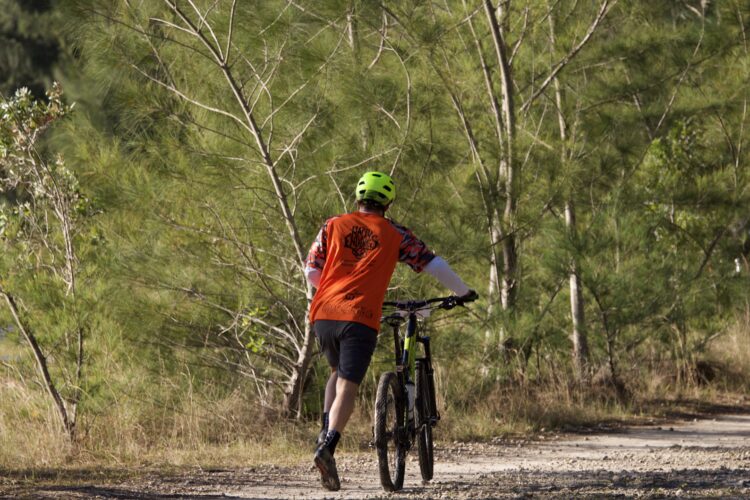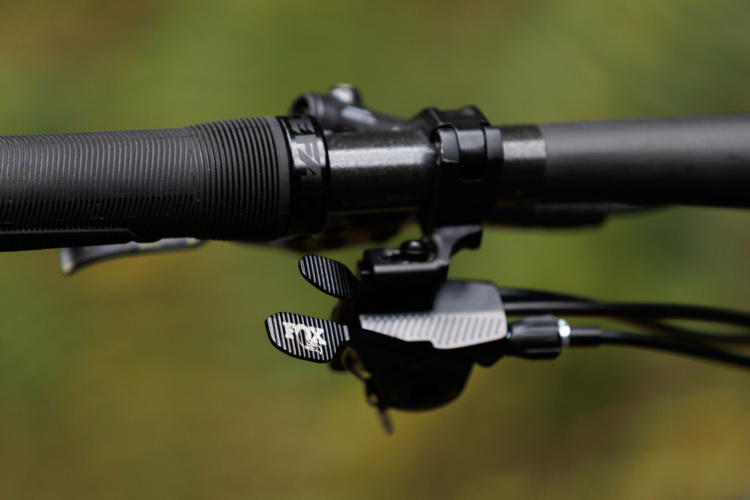
Are there any busted-carbon survivors in the audience? From handlebars and rims to chainstays and down tubes, carbon can crack on occasion. I personally have snapped a few carbon, aluminum, and steel frames alike, multiple carbon rims, and one set of black fiber cranks. It happens to all of us, and in fact, the legendary “carbon cowboy” Shawn Small broke his handlebar the weekend prior to our chat.
Shawn moved to Portland, Oregon just over 13 years ago, fresh out of school with a mechanical engineering degree from his home-state alma mater, University of Wisconsin-Milwaukee. He didn’t know anyone in the city at first but knew that he wanted to break into the bike industry somehow. He started a company called Ruckus Composites, initially creating carbon fiber chainring guards. Before we had true 1X drivetrains these guards would help keep the chain on a conventional chainring without a front derailleur mucking up the works.
One day a friend walked into the shop with a broken carbon road bike and asked if he could fix it. Shawn decided to give it a shot and has since honed the craft to be one of the top carbon bike repair specialists in the world. Today Ruckus does loads of contract work for a variety of different customers, including a good amount of aerospace manufacturing and bike frame analysis. They see between 2,500 and 3,000 customers annually and repair roughly 1,000 broken or cracked bike frames. Work comes in from all around the world, and when we chatted Shawn mentioned that there was a frame on the way from Saudi Arabia. Their main competitor in the space is Calfee Design, which has been at carbon repair since the beginning of carbon frames.

Some clients send in their bikes to see if they are damaged, as it’s impossible to find cracks that don’t break the paint. Ruckus uses ultrasound analysis and a newer phased-array process to detect damage and assess repairs. Often if someone has a really nasty crash or their car is rear-ended with bikes on the back, the frame can look fine. Shawn says that the analysis can provide peace of mind, or let the client know about hidden issues.
The main question I had for Shawn was around trends. Which carbon frame parts are breaking now that weren’t before, and what is more robust now that used to break all of the time?
To start with the good news, the worst issue has largely been resolved over the past three years. He said that the most frequent problem areas existed where carbon and aluminum bonded together. The alloy BB thread inserts and pivot bearing seats in a frame would often break loose and have to be re-bonded. According to Shawn, almost every brand has remedied this issue by improving the bonds or placing bearing seats directly in the carbon fiber with no alloy to bond. Better design and manufacturing processes have almost eliminated this issue that once made up the bulk of work for Ruckus.
A common breaking point for carbon tubes today is the underside of the down tube, near the bottom bracket. Chainrings are smaller now than they have ever been, no longer providing impact protection to the face of that tube. Additionally, once the front derailleur officially went away suspension pivots were able to move forward, allowing seat stays to shrink. In order to make space for the linkage, a shock mount, and a water bottle, most down tubes have gained a horizontal portion that juts out from behind the chainring before ascending toward the fork crown.


The rubberized protection on those down tubes does little to save the carbon when the bike hits a rock or stump. Shawn says that the protectors are more for smaller strikes and chips, and the number of broken down tubes continues alongside this trending frame shape. He says that the best thing riders could do to prevent this damage would be to mount a water bottle under the down tube. He gave the example of It working similarly to the large water-filled barrels on the highway that are intended to take large impacts without inflicting much damage. The bottle, water, and cage would dissipate the energy, and likely save a cracked tube wall.
Another regularly repaired mountain bike bit is where the frame sits over a pickup tailgate. It’s easy to mount up the tailgate pad incorrectly, or for the pad to shift, leaving your frame pounding directly against the steel. If we all drove shuttle runs on smooth grades at a reasonable speed this likely wouldn’t be an issue, but excited groups of friends throwing down party laps tend to hit the throttle a little hard — resulting in cracked and broken carbon frames. The solutions to this frequent fracture are to slow down, to use a thicker tailgate pad, strap bikes in tighter so they don’t bounce about, and to use a different bike moving system. Or, pedal to the top. Like the lower down tube protection, Shawn says that tailgate frame slabs do little to prevent the tubes form breaking.

Neglected maintenance can also cause bikes to break. Shawn mentioned that a lot of bikes come in with broken seat stays or other busted parts simply because the bearings had seized up long ago, leaving the frame to take all of the impact forces. Unchecked and under-serviced shocks can also play a part, again leaving the frame to do all of the work. In some cases customers will send in their shocks in with a broken frame and they have been running 10 PSI in the air spring, slamming all of the force into the carbon.
All that force comes by way of “bearings that seize up, or if their shock is blown for whatever reason, or it’s broken, or it’s too low pressure and they are getting air or just riding hard it puts so much stress on the frame. The frame wasn’t designed to take it. We’ve had plenty of bikes come in where people think they’re just riding along and ‘I broke this stupid mountain bike that’s supposed to be tough.'” In short, swapping pivot bearings seasonally and checking your shock pressure once a week can save a wad of cash.
Ruckus no longer repairs carbon rims and handlebars since those parts are comparatively inexpensive to replace. There are generally two prices for carbon tube repairs: $500 and $750. Both receive the same repair and care, and the $250 difference covers paint and graphic matching. If clients don’t need the graphics and paint rematched Ruckus will block the area and repaint it with flat black in a way that integrates as cleanly as possible with the rest of the frame aesthetic. If folks want everything to look like new, or to replace the paint with something custom, the price goes up quickly. Custom paint is often outsourced, with a bill that starts at roughly $1,200. If multiple tubes are fractured the job gets bundled, ending up less than $500 per tube.

Looking toward the future, Shawn says that he would like to see carbon frame designers focus on durability and safety when frames do break. “Mountain bikes are going to take damage, but how do we design the carbon structure to be what I call a damage tolerant design? And that’s a term used in the aerospace industry. Let’s say something takes damage, the whole structure doesn’t fail. Let’s say the top tube takes something pretty serious, but the bike doesn’t fall apart. That’s kind of some deeper level material engineering that, honestly is happening a little bit, which is pretty neat to see. I think that can really be the next evolution of designing composites to be pretty damage-proof. You know, there’s a baseball bat company here in Beaverton that builds carbon softball bats. You don’t just use those once and hang them up.”
On a separate future note, Shawn is working with an international organization to achieve equal pay for professional female bike racers. Once the pandemic ebbs he hopes to work with one of the women’s pro teams for a season, wrenching on bikes and analyzing the frames to make sure no one is riding a busted machine. He says that super light carbon road bikes are built tough, but pro athletes are hard on gear, and no bike is designed to be thrown into and out of airplanes fifty times in a year, smashed under suitcases. He says that all of the broken bikes in the pro road racing peloton could be prevented with regular carbon analysis.
Will you be bolting or strapping a water bottle to the down tube any time soon?





















3 Comments
May 3, 2021
May 6, 2021
May 4, 2021